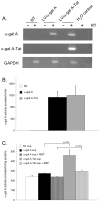Alpha-galactosidase A-Tat fusion enhances storage reduction in hearts and kidneys of Fabry mice
- PMID: 20454522
- PMCID: PMC2864812
- DOI: 10.2119/molmed.2009.00163
Alpha-galactosidase A-Tat fusion enhances storage reduction in hearts and kidneys of Fabry mice
Abstract
The protein transduction domain from human immunodeficiency virus (HIV) Tat allows proteins to penetrate the cell membrane. Enhanced cellular uptake of therapeutic proteins could benefit a number of disorders. This is especially true for lysosomal storage disorders (LSDs) where enzyme replacement therapy (ERT) and gene therapy have been developed. We developed a novel recombinant lentiviral vector (LV) that engineers expression of alpha-galactosidase A (alpha-gal A)-Tat fusion protein for correction of Fabry disease, the second-most prevalent LSD with manifestations in the brain, kidney and heart. In vitro experiments confirmed mannose-6-phosphate independent uptake of the fusion factor. Next, concentrated therapeutic LV was injected into neonatal Fabry mice. Analysis of tissues at 26 wks demonstrated similar alpha-gal A enzyme activities but enhanced globotriaosylceramide (Gb3) reduction in hearts and kidneys compared with the alpha-gal A LV control. This strategy might advance not only gene therapy for Fabry disease and other LSDs, but also ERT, especially for cardiac Fabry disease.
Figures




Similar articles
-
Lentivector transduction improves outcomes over transplantation of human HSCs alone in NOD/SCID/Fabry mice.Mol Ther. 2012 Jul;20(7):1454-61. doi: 10.1038/mt.2012.64. Epub 2012 Apr 3. Mol Ther. 2012. PMID: 22472949 Free PMC article.
-
Characterization of Fabry mice treated with recombinant adeno-associated virus 2/8-mediated gene transfer.J Biomed Sci. 2010 Apr 16;17(1):26. doi: 10.1186/1423-0127-17-26. J Biomed Sci. 2010. PMID: 20398385 Free PMC article.
-
Correction of cardiac abnormalities in fabry mice by direct intraventricular injection of a recombinant lentiviral vector that engineers expression of alpha-galactosidase A.Circ J. 2006 Nov;70(11):1503-8. doi: 10.1253/circj.70.1503. Circ J. 2006. PMID: 17062978
-
Genetics and Gene Therapy of Anderson-Fabry Disease.Curr Gene Ther. 2018;18(2):96-106. doi: 10.2174/1566523218666180404161315. Curr Gene Ther. 2018. PMID: 29618309 Review.
-
Therapeutic advances in Fabry disease: The future awaits.Biomed Pharmacother. 2020 Nov;131:110779. doi: 10.1016/j.biopha.2020.110779. Epub 2020 Sep 23. Biomed Pharmacother. 2020. PMID: 33152937 Review.
Cited by
-
Intracellular Delivery of Proteins with Cell-Penetrating Peptides for Therapeutic Uses in Human Disease.Int J Mol Sci. 2016 Feb 22;17(2):263. doi: 10.3390/ijms17020263. Int J Mol Sci. 2016. PMID: 26907261 Free PMC article. Review.
-
Systemic mRNA Therapy for the Treatment of Fabry Disease: Preclinical Studies in Wild-Type Mice, Fabry Mouse Model, and Wild-Type Non-human Primates.Am J Hum Genet. 2019 Apr 4;104(4):625-637. doi: 10.1016/j.ajhg.2019.02.003. Epub 2019 Mar 14. Am J Hum Genet. 2019. PMID: 30879639 Free PMC article.
-
HIV Tat Domain Improves Cross-correction of Human Galactocerebrosidase in a Gene- and Flanking Sequence-dependent Manner.Mol Ther Nucleic Acids. 2013 Oct 22;2(10):e130. doi: 10.1038/mtna.2013.57. Mol Ther Nucleic Acids. 2013. PMID: 24150577 Free PMC article.
-
Cell-Penetrating Peptide Enhances Tafazzin Gene Therapy in Mouse Model of Barth Syndrome.Int J Mol Sci. 2024 Dec 18;25(24):13560. doi: 10.3390/ijms252413560. Int J Mol Sci. 2024. PMID: 39769321 Free PMC article.
-
Hypercalcemia induces a proinflammatory phenotype in rat leukocytes and endothelial cells.J Physiol Biochem. 2013 Jun;69(2):199-205. doi: 10.1007/s13105-012-0202-y. Epub 2012 Aug 9. J Physiol Biochem. 2013. PMID: 23011779
References
-
- Brady RO, et al. Enzymatic defect in Fabry’s disease. Ceramidetrihexosidase deficiency. N Engl J Med. 1967;276:1163–7. - PubMed
-
- Nakao S, et al. An atypical variant of Fabry’s disease in men with left ventricular hypertrophy. N Engl J Med. 1995;333:288–93. - PubMed
-
- Sachdev B, et al. Prevalence of Anderson-Fabry disease in male patients with late onset hypertrophic cardiomyopathy. Circulation. 2002;105:1407–11. - PubMed
-
- Banikazemi M, et al. Agalsidase-beta therapy for advanced Fabry disease: a randomized trial. Ann Intern Med. 2007;146:77–86. - PubMed
-
- Weidemann F, et al. Long-term effects of enzyme replacement therapy on Fabry cardiomyopathy: evidence for a better outcome with early treatment. Circulation. 2009;119:524–9. - PubMed
Publication types
MeSH terms
Substances
Grants and funding
LinkOut - more resources
Full Text Sources
Medical
Molecular Biology Databases

